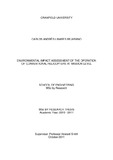JavaScript is disabled for your browser. Some features of this site may not work without it.
| dc.contributor.advisor | Smith, Howard | |
| dc.contributor.author | Linares Bejarano, Carlos Andres | |
| dc.date.accessioned | 2012-05-21T10:06:16Z | |
| dc.date.available | 2012-05-21T10:06:16Z | |
| dc.date.issued | 2011-10 | |
| dc.identifier.uri | http://dspace.lib.cranfield.ac.uk/handle/1826/7167 | |
| dc.description.abstract | Helicopters play a unique role in modern aviation providing a varied range of benefits to society and satisfying the need for fast mobility, particularly in metropolitan areas. However, environmental concerns associated with the operation of rotorcraft have increased due to envisaged growth of air traffic. Even though helicopter operations represent a small percentage of the total greenhouse gas emissions resulting from all human activities, helicopters are categorised as a main source of local air pollution around airports and urban areas. New rotorcraft designs, innovative aero engines and all-electrical systems are being developed in order to diminish the impact that aviation has on the global and local environment. However, advanced rotorcraft designs and breakthrough technologies might take decades to be in service. Additionally, there is a large number of polluting rotorcraft that are in use and must be progressively replaced. Therefore, in the near-term, improvements to minimise air quality degradation (around airports and metropolitan areas) may be possible from better use of existing rotorcraft by focusing on trajectory and mission profile management. In this research project, a parametric study was carried out in order to assess the environmental impact, in terms of fuel burn and emissions, that the operation of light single-engine helicopters causes under different flight conditions. The results of this assessment were used as a basis to carry out a single and multi-objective optimisation for minimum fuel consumption and air pollutant emissions. Oxides of nitrogen, carbon monoxide and unburnt hydrocarbons were considered as trade-off parameters. In order to achieve this, a multidisciplinary assessment framework, intended to generate outputs for estimating the fuel burn and emissions during the operation of conventional helicopters, was developed. Simulink® Design Optimization™ software was incorporated into the framework in order to enhance the benefits of this tool.A baseline mission profile was proposed in order to validate the potential of mission profile management. Different case studies were carried out changing flight parameters at every segment of the baseline mission. The single and multi-objective optimisation proved that favourable reductions in fuel burn may be attainable at the expense of a slight increase of NOX emissions during the entire mission. If reductions of more than 3% in block fuel burn are to be achievable in the short term for a single helicopter, savings for air transport companies are expected to be significant if mission profile management is considered for a whole fleet of helicopters. | en_UK |
| dc.language.iso | en | en_UK |
| dc.publisher | Cranfield University | en_UK |
| dc.rights | © Cranfield University 2011. All rights reserved. No part of this publication may be reproduced without the written permission of the copyright owner. | en_UK |
| dc.subject | Environment | en_UK |
| dc.subject | Rotorcraft | en_UK |
| dc.subject | Emissions | en_UK |
| dc.subject | Performance | en_UK |
| dc.subject | Mission Profile | en_UK |
| dc.subject | Operations | en_UK |
| dc.subject | Impact | en_UK |
| dc.title | Environmental impact assessment of the operation of conventional helicopters at mission level | en_UK |
| dc.type | Thesis or dissertation | en_UK |
| dc.type.qualificationlevel | Masters | en_UK |
| dc.type.qualificationname | MSc | en_UK |
